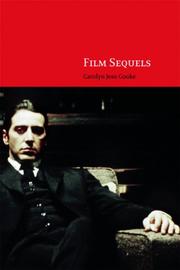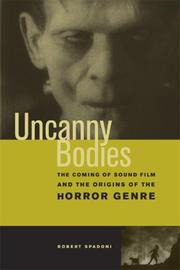| Listing 1 - 8 of 8 |
Sort by
|
Book
ISBN: 9781845532024 1845537300 9781845537302 1845532023 Year: 2009 Publisher: London ; Oakville, CT : Equinox,
Abstract | Keywords | Export | Availability | Bookmark
 Loading...
Loading...Choose an application
- Reference Manager
- EndNote
- RefWorks (Direct export to RefWorks)
Commissioned and edited to appeal to a crossover Film and Music Studies readership, Terror Tracks is an anthology that analyses the use of music and sound in the popular genre of Horror cinema. Focusing on the post-War period, contributors analyse the role of music and sound in establishing and enhancing the senses of unease, suspense and shock crucial to the genre. The anthology shows the various patterns of use an inflection in a range of scores - orchestral, popular, rock and electronic - and how these relate to non-musical sound. Lively and accessible, Terror Tracks is an important contribution
Musique de film --- Films d'horreur --- Histoire et critique --- Horror films --- Motion picture music --- History and criticism. --- Histoire et critique.

ISBN: 9780748626038 9780748631339 9780748626045 074863133X 0748626034 1282058959 9781282058958 0748689478 9780748689477 0748670890 9780748670895 9786612058950 6612058951 0748626042 Year: 2009 Publisher: Edinburgh Edinburgh University Press
Abstract | Keywords | Export | Availability | Bookmark
 Loading...
Loading...Choose an application
- Reference Manager
- EndNote
- RefWorks (Direct export to RefWorks)
The film sequel has been much maligned in popular culture as a vampirish corporative exercise in profit-making and narrative regurgitation. Drawing upon a wide range of filmic examples from early cinema to the twenty-first century, this exciting new volume reveals the increasing popularity of, and experimentation with, film sequels as a central dynamic of Hollywood cinema. Now creeping into world cinemas and independent film festivals, the sequel is persistently employed as a vehicle for cross-cultural dialogue and as a structure by which memories and cultural narratives can be circulated across geographical and historical locations. This book aims to account for some of the major critical contexts within which sequelisation operates by exploring sequel production beyond box office figures. Its account ranges across sequels in recent mainstream cinema, art-house and 'indie' sequels, non-Hollywood sequels, the effects of the domestic market on sequelisation, and the impact of the video game industry on Hollywood. The book: *Situates the sequel within its industrial, cultural, theoretical and global contexts. *Offers an essential resource for students and critics interested in film and literary studies, adaptation, critical theory and cultural studies. *Provides the first study of film sequels in world cinemas and independent film-making.
Film --- Film sequels. --- Motion picture industry --- Motion picture sequels --- Motion pictures --- Moving-picture sequels --- Sequels, Film --- Film series --- Sequels --- Cinéma --- Films d'horreur --- Cinéma indépendant --- Suites --- Histoire et critique --- Etats-Unis --- Suties --- Inde
Book
ISBN: 0857282417 1282138596 9786613807977 085728455X 9780857284556 9780857282415 9780857284495 0857284495 0857284509 9780857284501 9781282138599 9780857284570 Year: 2012 Publisher: London Anthem Press
Abstract | Keywords | Export | Availability | Bookmark
 Loading...
Loading...Choose an application
- Reference Manager
- EndNote
- RefWorks (Direct export to RefWorks)
Horror films can be profound fables of human nature and important works of art, yet many people dismiss them out of hand. Horror and the Horror Film conveys a mature appreciation for horror films along with a comprehensive view of their narrative strategies, their relations to reality and fantasy and their cinematic power. The volume covers the horror film and its subgenres such as the vampire movie from 1896 to the present. It covers the entire genre by considering every kind of monster in it, including the human.
Horror films --- Motion picture industry --- Film industry (Motion pictures) --- Moving-picture industry --- Cultural industries --- History and criticism. --- Films d'horreur --- Histoire et critique --- Horror films. --- Production and direction. --- Spookfests (Motion pictures) --- Motion pictures --- Haunted house films --- Monster films --- Direction
Book
ISBN: 9789622099722 9789622099739 9622099726 9622099734 9786612708992 9888052373 9882207022 1282708996 9789888052370 9789882207028 9781282708990 6612708999 Year: 2009 Publisher: Aberdeen Hong Kong University Press
Abstract | Keywords | Export | Availability | Bookmark
 Loading...
Loading...Choose an application
- Reference Manager
- EndNote
- RefWorks (Direct export to RefWorks)
This book compares production and consumption of Asian horror cinemas in different national contexts and their multidirectional dialogues with Hollywood and neighboring Asian cultures.
Film --- Asia --- Horror films --- Films d'horreur --- History and criticism --- Cross-cultural studies --- Histoire et critique --- Etudes transculturelles --- Horror films -- Asia -- Cross-cultural studies. --- Horror films -- Asia -- History and criticism. --- Music, Dance, Drama & Film --- History and criticism. --- Spookfests (Motion pictures) --- Motion pictures --- Haunted house films --- Monster films
Book
ISBN: 1442624035 9781442624030 9781442650541 1442650540 9781442628502 1442628502 1442624043 Year: 2015 Publisher: Toronto Buffalo London
Abstract | Keywords | Export | Availability | Bookmark
 Loading...
Loading...Choose an application
- Reference Manager
- EndNote
- RefWorks (Direct export to RefWorks)
Featuring chapters on Pontypool, Ginger Snaps, 1970s slasher films, Quebec horror, and the work of David Cronenberg, among many others, The Canadian Horror Film unearths the terrors hidden in the recesses of the Canadian psyche.
Horror films --- Films d'horreur --- Spookfests (Motion pictures) --- Motion pictures --- Haunted house films --- Monster films --- History and criticism. --- Histoire et critique. --- Canada. --- Canada (Province) --- Canadae --- Ceanada --- Chanada --- Chanadey --- Dominio del Canad --- Dominion of Canada --- Jianada --- Kʻaenada --- Kanada --- Ḳanadah --- Kanadaja --- Kanadas --- Ḳanade --- Kanado --- Kanak --- Province of Canada --- Republica de Canad --- Yn Chanadey --- Dominio del Canadá --- Kaineḍā --- Kanakā --- Republica de Canadá
Book
ISBN: 1350987646 1786721376 1786731371 9781786731371 9781786721372 9781786731371 1784536865 9781784536862 Year: 2016 Publisher: London, England : London, England : I.B. Tauris & Co. Ltd, Bloomsbury Publishing,
Abstract | Keywords | Export | Availability | Bookmark
 Loading...
Loading...Choose an application
- Reference Manager
- EndNote
- RefWorks (Direct export to RefWorks)
In recent years, the representation of alternative sexuality in the horror film and television has 'outed' itself from the shadows from which it once lurked via the embrace of an outrageously queer horror aesthetic where homosexuality is often unequivocally referenced. In this book, Darren Elliott-Smith departs from the analysis of the monster as a symbol of heterosexual anxiety and fear, and moves to focus instead on queer fears and anxieties within gay male subcultures. Furthermore, he examines the works of significant queer horror film and television producers and directors to reveal gay men's anxieties about: acceptance and assimilation into Western culture, the perpetuation of self-loathing and gay shame, and further anxieties surrounding associations shameful femininity. This book focuses mainly on representations of masculinity and gay male spectatorship in queer horror film and television post-2000. In titling this sub-genre 'queer horror', Elliott-Smith designates horror that is crafted by male directors/producers who self-identify as gay, bi, queer or transgendered and whose work features homoerotic, or explicitly homosexual, narratives with 'out' gay characters.
Homosexuality and motion pictures. --- Homosexuality in motion pictures. --- Horror films --- Sex role in motion pictures. --- History and criticism. --- Motion pictures --- Motion pictures and homosexuality --- Horror films. --- Horrorfilm. --- Sex role in motion pictures --- Homosexuality in motion pictures --- Homosexuality and motion pictures --- Films d'horreur --- Homosexualité --- Rôle selon le sexe --- History and criticism --- À la télévision. --- Au cinéma. --- Carrie --- Homosexualité --- Rôle selon le sexe --- À la télévision. --- Au cinéma.
Book
ISBN: 9783837637359 3837637352 3839437350 9783839437353 Year: 2017 Publisher: Bielefeld
Abstract | Keywords | Export | Availability | Bookmark
 Loading...
Loading...Choose an application
- Reference Manager
- EndNote
- RefWorks (Direct export to RefWorks)
The monsters of the horror genre never remain dead - they invariably return in new and terrifying shapes for another installment. In this study Christian Knöppler explores the phenomenon of horror film remakes. He argues that even though these derivative films typically earn little praise from critics, their constant refiguration of monsters and horror scenarios serves to access and update otherwise obscure cultural fears. With an in-depth examination of six sample sequences of films and remakes, this book aims to shed new light on a much maligned and often neglected type of film and promises fresh insights to scholars and aficionados alike. Besprochen in: www.hhprinzler.de, 30.03.2017, Hans Helmut Prinzler MEDIENwissenschaft, 4 (2017), Maribel Cedeno Rojas
Horror films --- Films d'horreur --- Film remakes --- Remakes (cinéma) --- History and criticism. --- Histoire et critique --- Motion pictures --- Motion picture remakes --- Moving-picture remakes --- Remakes, Film --- Social aspects --- Remakes --- Histoire et critique. --- Film; Horror; Remake; Media; Culture; Cultural Fear; Popular Culture; The Thing; Invasion of the Body Snatchers; The Crazies; Dawn of the Dead; The Texas Chainsaw Massacre; Halloween; America; Media Aesthetics; Media Studies --- America. --- Cultural Fear. --- Culture. --- Dawn of the Dead. --- Halloween. --- Horror. --- Invasion of the Body Snatchers. --- Media Aesthetics. --- Media Studies. --- Media. --- Popular Culture. --- Remake. --- The Crazies. --- The Texas Chainsaw Massacre. --- The Thing. --- Remakes (cinéma)

ISBN: 9780520251229 9780520251212 0520251210 0520251229 128138562X 0520940709 9786611385620 1435653653 9780520940703 6611385622 9781435653658 Year: 2007 Publisher: Berkeley University of California Press
Abstract | Keywords | Export | Availability | Bookmark
 Loading...
Loading...Choose an application
- Reference Manager
- EndNote
- RefWorks (Direct export to RefWorks)
In 1931 Universal Pictures released Dracula and Frankenstein, two films that inaugurated the horror genre in Hollywood cinema. These films appeared directly on the heels of Hollywood's transition to sound film. Uncanny Bodies argues that the coming of sound inspired more in these massively influential horror movies than screams, creaking doors, and howling wolves. A close examination of the historical reception of films of the transition period reveals that sound films could seem to their earliest viewers unreal and ghostly. By comparing this audience impression to the first sound horror films, Robert Spadoni makes a case for understanding film viewing as a force that can powerfully shape both the minutest aspects of individual films and the broadest sweep of film production trends, and for seeing aftereffects of the temporary weirdness of sound film deeply etched in the basic character of one of our most enduring film genres.
Horror films --- Sound motion pictures --- Films d'horreur --- Films sonores --- History and criticism. --- Histoire et critique --- 82:791.43 --- Literatuur en film --- Horror films - United States - History and criticism. --- Horror films. --- Sound motion pictures - History and criticism. --- Film --- Music, Dance, Drama & Film --- History and criticism --- 82:791.43 Literatuur en film --- Moving-pictures, Talking --- Talkies --- Talking motion pictures --- Motion pictures --- 20th century american culture. --- 20th century american film history. --- american culture. --- american film history. --- american movie history. --- audience reception. --- cinema. --- classic horror cinema. --- dark. --- dracula. --- early sound film. --- film studies. --- filmmaking. --- frankenstein. --- hollywood cinema. --- horror genre. --- horror movies. --- intense. --- modality. --- movie studies. --- sound film. --- svengali. --- the hollywood review of 1929. --- uncanny theater. --- united states of america. --- universal pictures. --- vampires. --- ventriloquism.
| Listing 1 - 8 of 8 |
Sort by
|

 Search
Search Feedback
Feedback About UniCat
About UniCat  Help
Help News
News